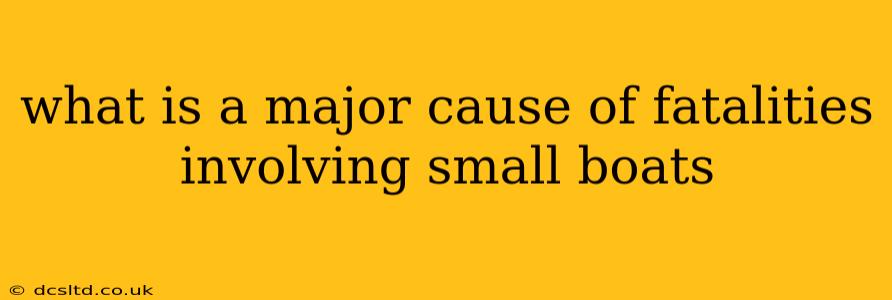What is a Major Cause of Fatalities Involving Small Boats?
Drowning is the leading cause of death in boating accidents involving small vessels. While many factors contribute to these tragedies, a significant portion stems from a lack of proper safety precautions and understanding of water conditions. This isn't simply about "accidents" – it's often a preventable consequence of negligence or insufficient preparation. Let's delve into the specifics.
What are the main causes of boating accidents resulting in fatalities?
The most prevalent causes of boating fatalities are multifaceted, often interconnected:
-
Capsizing/Swamping: Small boats, especially those improperly loaded or encountering unexpectedly rough weather, are highly susceptible to capsizing or swamping. This quickly leads to individuals being thrown into the water, often without life jackets.
-
Drowning: As mentioned, drowning is the overwhelmingly dominant cause of death in these accidents. Many victims lack the skills or equipment needed to survive a capsizing or fall overboard.
-
Alcohol Use: Impaired judgment due to alcohol consumption significantly increases the risk of accidents. Alcohol affects coordination, decision-making, and awareness of potential dangers, leading to reckless operation and increased vulnerability.
-
Lack of Life Jackets: A staggering number of boating fatalities involve victims who were not wearing life jackets. Even strong swimmers can succumb to exhaustion, hypothermia, or other factors in the water.
-
Inadequate Training/Experience: Operating a small boat safely requires understanding navigation, weather patterns, and basic boat handling. Lack of proper training or experience increases the likelihood of accidents.
-
Collision with other vessels or objects: Collisions, often resulting from poor visibility, inattention, or reckless operation, can lead to serious injuries and fatalities.
-
Severe Weather: Sudden changes in weather conditions, such as unexpected storms or strong winds, can quickly overwhelm small boats, leading to capsizing or other emergencies.
What are some safety measures to prevent boating fatalities?
Preventing fatalities requires a multi-pronged approach encompassing:
-
Life Jacket Usage: Always wear a properly fitted life jacket whenever you're on a small boat, regardless of the weather or distance from shore. This is the single most effective measure.
-
Boating Education: Take a boating safety course to learn proper navigation, boat handling, and emergency procedures. Understanding weather patterns and recognizing potential hazards is crucial.
-
Weather Awareness: Always check the weather forecast before heading out and monitor conditions throughout your trip. Be prepared to return to shore if conditions deteriorate.
-
Alcohol Avoidance: Never operate a boat under the influence of alcohol or drugs. Designate a sober operator.
-
Proper Boat Maintenance: Ensure your boat is in good working order, including the engine, lights, and safety equipment. Regular maintenance is essential.
-
Passenger Safety: Educate passengers on safety procedures, including the location of safety equipment and emergency procedures.
-
Navigation: Use charts, GPS, and other navigational aids to ensure you are aware of your location and potential hazards.
What is the most common cause of death in small boat accidents?
The most common cause of death in small boat accidents is drowning. This underscores the critical importance of life jackets and other safety measures.
How can I improve my safety on a small boat?
Improving safety involves consistent adherence to safety procedures, regular boat maintenance, and ongoing education. Never underestimate the power of the water and the potential dangers involved in small-boat operation.
By understanding the major causes of small-boat fatalities and actively implementing safety measures, we can significantly reduce the risk of these tragic events. Remember, a moment of carelessness can have devastating consequences.
